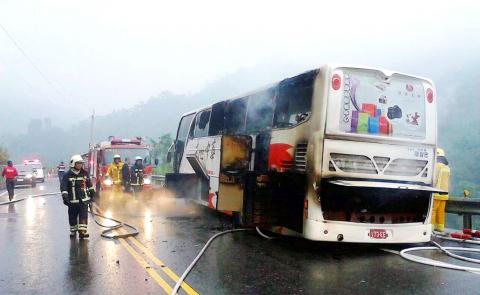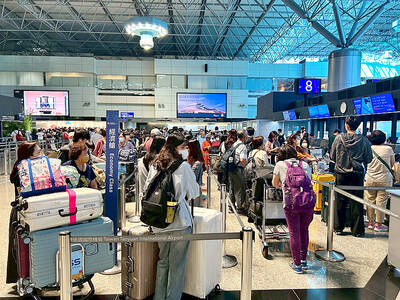A tour bus carrying 38 Chinese tourists caught fire yesterday afternoon when driving on the Alishan Highway, slightly injuring two people and causing one other to have a heart attack.
According to the Tourism Bureau, the accident occurred at about 3:55pm at the 38.5km milestone. The two injured Chinese tourists were identified as 62-year-old woman Tieh Yen (鐵燕) and 61-year-old woman Li Fongzhi (李鳳芝). Meanwhile, 68-year-old woman Chang Hsiurong (張秀榮) had a heart attack and was taken to a hospital in Chiayi County for treatment.
The bureau also said that the Chinese tourists are from Beijing and belong to a Taiwan’s Jubilant Travel Service tour group. The tour bus was manufactured in 2010 and was inspected by the Directorate-General of Highways (DGH) four months ago.

Photo: CNA
The DGH said that the bus driver had noticed something different about the bus and hit the brakes after he heard a loud bang. He then found that the right wheel at the back of the bus was on fire and quickly evacuated all the passengers.
The driver quickly put out the fire with a fire extinguisher, so no casualties were reported, the DGH said.
In other developments, seven national scenic areas have been asked to improve marine safety following the rogue wave accident that killed eight people earlier this month.
The bureau said the North Coast and Guanyinshan National Scenic Area as well as scenic areas on the northeast coast, the east coast, the southwest coast, Dapeng Bay, Penghu and Matsu have been given guidelines to improve marine safety. Representatives from these scenic areas are to meet with the Central Weather Bureau on Monday to discuss the viability of establishing an alert system for rogue waves.
The national scenic areas would also install more life-saving equipment, warning signs and surveillance systems, the bureau added.

The Chinese military has built landing bridge ships designed to expand its amphibious options for a potential assault on Taiwan, but their combat effectiveness is limited due to their high vulnerability, a defense expert said in an analysis published on Monday. Shen Ming-shih (沈明室), a research fellow at the Institute for National Defense and Security Research, said that the deployment of such vessels as part of the Chinese People’s Liberation Army (PLA) Navy’s East Sea Fleet signals a strong focus on Taiwan. However, the ships are highly vulnerable to precision strikes, which means they could be destroyed before they achieve their intended

About 4.2 million tourist arrivals were recorded in the first half of this year, a 10 percent increase from the same period last year, the Tourism Administration said yesterday. The growth continues to be consistent, with the fourth quarter of this year expected to be the peak in Taiwan, the agency said, adding that it plans to promote Taiwan overseas via partnerships and major events. From January to June, 9.14 million international departures were recorded from Taiwan, an 11 percent increase from the same period last year, with 3.3 million headed for Japan, 1.52 million for China and 832,962 to South Korea,

SOVEREIGNTY: The rigs show that Beijing ‘rejects Taiwan’s jurisdiction’ by building in areas where Taipei demands permission to build or alter installations Chinese oil rigs have been sighted just 26 nautical miles (42km), from Taiwan’s exclusive economic zone (EEZ) near Pratas Island (Dongsha Island, 東沙島), posing a threat to Taiwan’s sovereignty if left unchallenged, a brief published by the Jamestown Foundation on Tuesday said. Pratas Island, 444km from Kaohsiung, is northeast of the South China Sea and houses a Taiwanese garrison. The brief, titled “Rigging the Game: PRC Oil Structures Encroach on Taiwan’s Pratas Island” — referring to the People’s Republic of China — analyzed photographs and said that Beijing’s tools to pressure Taiwan now include oil rigs. “Oil rigs now constitute part of Beijing’s

The Taiwan Experience Education Program (TEEP) has funded short-term internships in Taiwan for more than 4,500 young people from more than 40 countries since 2015, with the goal of attracting and retaining international talent, the Ministry of Education said yesterday. Fifty-five colleges launched 514 projects this year, including in fields such as semiconductors, artificial intelligence, medicine and biotechnology, green energy, and sustainability, it said. The program provides research and practical internships in Taiwan for two to six months, and offers cultural exchange and networking opportunities, the ministry said. For example, National Formosa University’s Embedded System and Autopilot Laboratory developed two solar-powered drones in